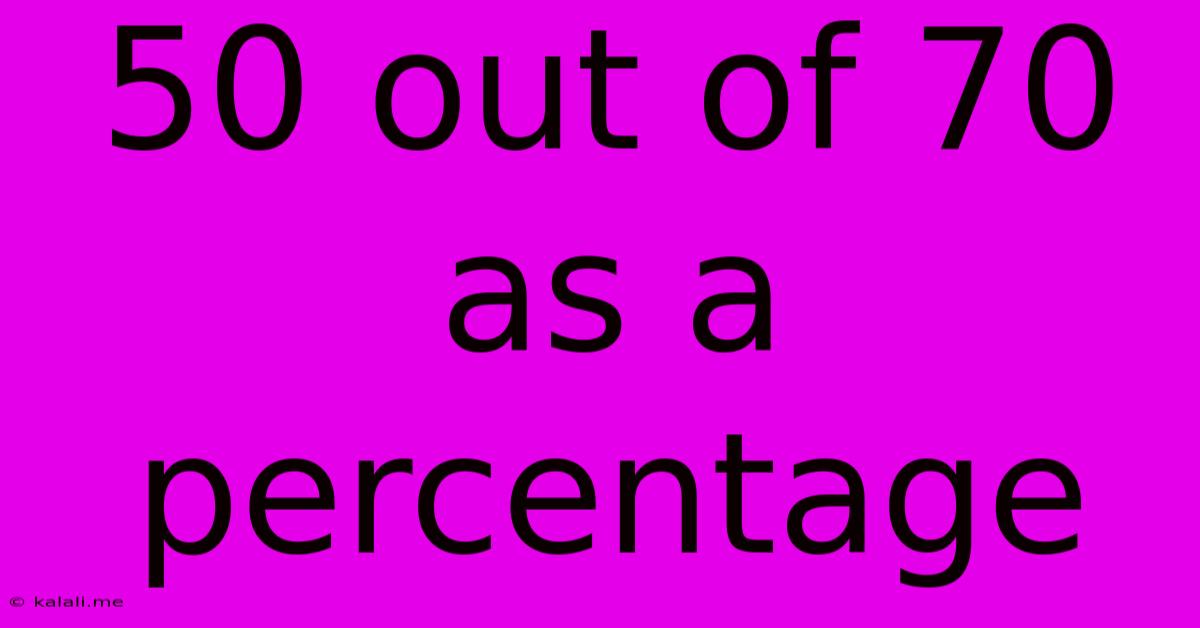50 Out Of 70 As A Percentage
Kalali
May 09, 2025 · 2 min read

Table of Contents
50 out of 70 as a Percentage: A Simple Calculation and Its Applications
So, you've got 50 out of 70, and you want to know what that is as a percentage? This is a common calculation, useful in many situations from school grades to business performance analysis. This article will guide you through the calculation, explain the process, and show you how to apply this knowledge to different contexts. Understanding percentages is a fundamental skill with broad applications.
Calculating 50 out of 70 as a Percentage:
The core concept is to express the ratio of 50 to 70 as a fraction of 100. Here's how:
-
Set up the fraction: Write the score as a fraction: 50/70
-
Convert to a decimal: Divide the numerator (50) by the denominator (70): 50 ÷ 70 ≈ 0.714
-
Convert to a percentage: Multiply the decimal by 100: 0.714 x 100 = 71.4%
Therefore, 50 out of 70 is approximately 71.4%.
Understanding Percentage Calculations:
The process above demonstrates a fundamental mathematical concept. You can apply this same method to calculate any percentage. The formula is:
(Part / Whole) x 100 = Percentage
Where:
- Part: The specific amount you're interested in (in this case, 50).
- Whole: The total amount (in this case, 70).
This formula is incredibly versatile. You can use it to calculate:
- Grades: Determining your percentage score on a test or assignment.
- Discounts: Calculating the savings on a sale item.
- Progress: Tracking your completion rate on a project.
- Statistics: Analyzing data in various fields, including business, science, and social studies.
- Financial Calculations: Determining interest rates, profit margins, and other key financial metrics.
Practical Applications of Percentage Calculations:
Understanding percentages is crucial for navigating many aspects of daily life and professional work. Here are some examples:
- Academic Performance: Converting test scores and assignment marks into percentages provides a standardized way to assess academic progress.
- Sales and Marketing: Analyzing sales figures, conversion rates, and marketing campaign effectiveness often involves percentage calculations.
- Finance: Understanding interest rates, loan payments, and investment returns relies heavily on percentage calculations.
- Data Analysis: Percentages are widely used to represent proportions and trends in data sets, facilitating better interpretation and decision-making.
Beyond the Basics: Rounding and Precision:
In the calculation above, we rounded the percentage to one decimal place (71.4%). The level of precision you need will depend on the context. For instance, a grade might be rounded to the nearest whole number, while a financial calculation might require greater accuracy.
Conclusion:
Calculating percentages is a valuable skill with widespread applicability. By understanding the basic formula and its variations, you can confidently tackle percentage calculations in diverse contexts, from everyday tasks to complex analytical problems. Mastering this skill will improve your ability to interpret data, make informed decisions, and navigate various aspects of your personal and professional life.
Latest Posts
Related Post
Thank you for visiting our website which covers about 50 Out Of 70 As A Percentage . We hope the information provided has been useful to you. Feel free to contact us if you have any questions or need further assistance. See you next time and don't miss to bookmark.